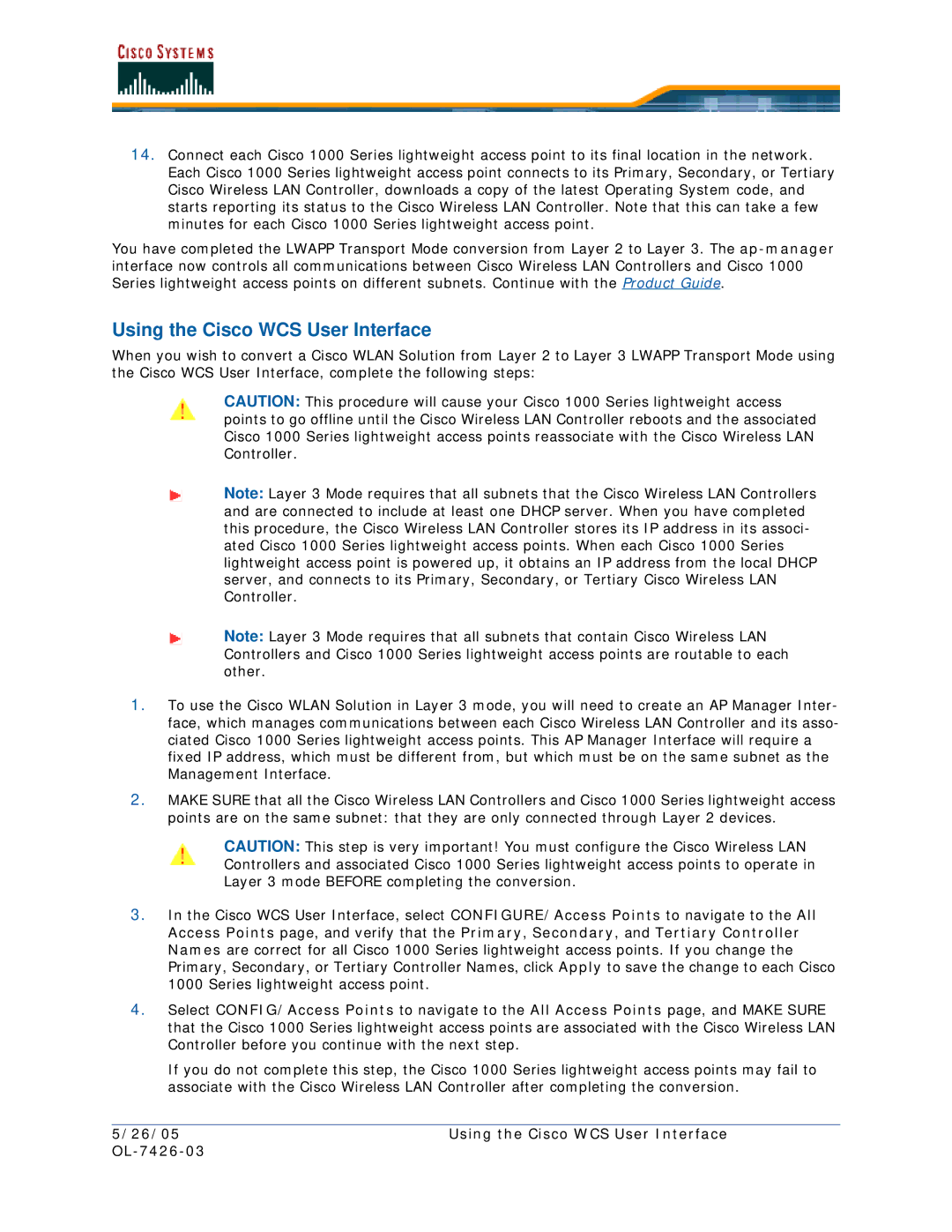
14.Connect each Cisco 1000 Series lightweight access point to its final location in the network. Each Cisco 1000 Series lightweight access point connects to its Primary, Secondary, or Tertiary Cisco Wireless LAN Controller, downloads a copy of the latest Operating System code, and starts reporting its status to the Cisco Wireless LAN Controller. Note that this can take a few minutes for each Cisco 1000 Series lightweight access point.
You have completed the LWAPP Transport Mode conversion from Layer 2 to Layer 3. The
Using the Cisco WCS User Interface
When you wish to convert a Cisco WLAN Solution from Layer 2 to Layer 3 LWAPP Transport Mode using the Cisco WCS User Interface, complete the following steps:
CAUTION: This procedure will cause your Cisco 1000 Series lightweight access points to go offline until the Cisco Wireless LAN Controller reboots and the associated Cisco 1000 Series lightweight access points reassociate with the Cisco Wireless LAN Controller.
Note: Layer 3 Mode requires that all subnets that the Cisco Wireless LAN Controllers and are connected to include at least one DHCP server. When you have completed this procedure, the Cisco Wireless LAN Controller stores its IP address in its associ- ated Cisco 1000 Series lightweight access points. When each Cisco 1000 Series lightweight access point is powered up, it obtains an IP address from the local DHCP server, and connects to its Primary, Secondary, or Tertiary Cisco Wireless LAN Controller.
Note: Layer 3 Mode requires that all subnets that contain Cisco Wireless LAN Controllers and Cisco 1000 Series lightweight access points are routable to each other.
1.To use the Cisco WLAN Solution in Layer 3 mode, you will need to create an AP Manager Inter- face, which manages communications between each Cisco Wireless LAN Controller and its asso- ciated Cisco 1000 Series lightweight access points. This AP Manager Interface will require a fixed IP address, which must be different from, but which must be on the same subnet as the Management Interface.
2.MAKE SURE that all the Cisco Wireless LAN Controllers and Cisco 1000 Series lightweight access points are on the same subnet: that they are only connected through Layer 2 devices.
CAUTION: This step is very important! You must configure the Cisco Wireless LAN Controllers and associated Cisco 1000 Series lightweight access points to operate in Layer 3 mode BEFORE completing the conversion.
3.In the Cisco WCS User Interface, select CONFIGURE/Access Points to navigate to the All Access Points page, and verify that the Primary, Secondary, and Tertiary Controller Names are correct for all Cisco 1000 Series lightweight access points. If you change the Primary, Secondary, or Tertiary Controller Names, click Apply to save the change to each Cisco 1000 Series lightweight access point.
4.Select CONFIG/Access Points to navigate to the All Access Points page, and MAKE SURE that the Cisco 1000 Series lightweight access points are associated with the Cisco Wireless LAN Controller before you continue with the next step.
If you do not complete this step, the Cisco 1000 Series lightweight access points may fail to associate with the Cisco Wireless LAN Controller after completing the conversion.
5/26/05 | Using the Cisco WCS User Interface |
|
|
